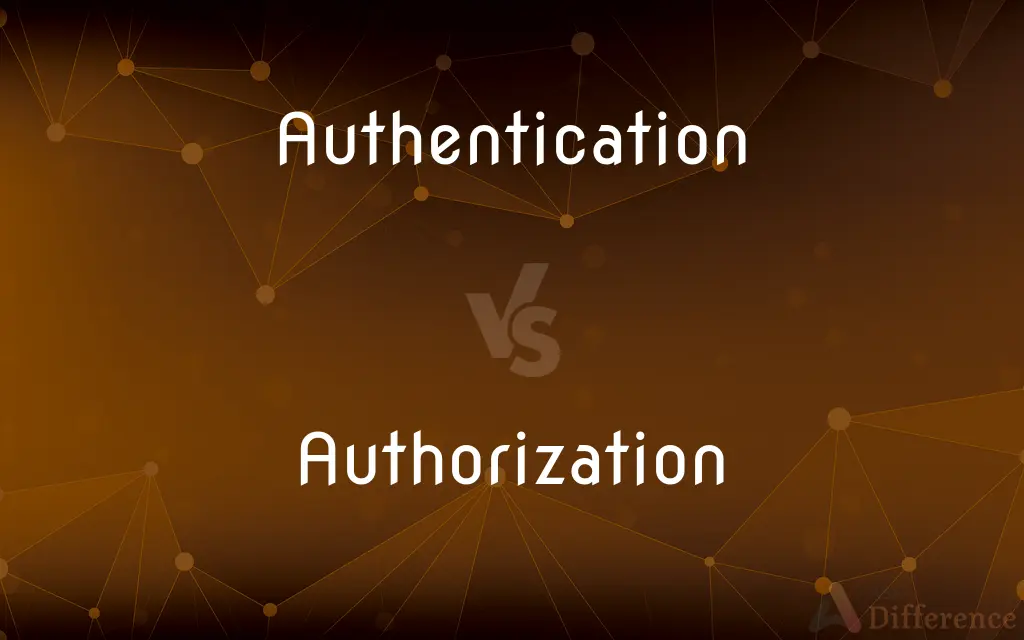Authentication vs. Authorization — What's the Difference?
By Tayyaba Rehman — Updated on September 22, 2023
Authentication verifies identity; Authorization grants permissions. They're integral to system security, defining user interaction limits.

Difference Between Authentication and Authorization
Table of Contents
ADVERTISEMENT
Key Differences
Authentication and Authorization are fundamental components of system security. Authentication is the process by which a system verifies the identity of a user, device, or another system. It's like proving one's identity at the entrance of a secured facility. Authorization, in contrast, is the process of granting or denying access to specific resources within the system. It’s akin to being given access to specific rooms within the facility once identity is proven.
Authentication is often the step that precedes Authorization. It usually involves the user providing credentials such as a username and password. Once Authentication is successful, the system determines what level of access the user should have, based on the Authorization that has been assigned to them. The Authorization process checks the permissions associated with the authenticated user and allows or restricts access accordingly.
Authentication and Authorization, although interconnected, serve different purposes. Authentication establishes trust by verifying the user's identity, ensuring that the user is who they claim to be. Authorization, following Authentication, provides access controls by assigning permissions and determining what resources the authenticated user can access or modify.
Authentication can involve various methods such as passwords, biometric scans, or multi-factor authentication. It is crucial to secure access points and verify identities accurately. Authorization is similarly vital as it ensures that authenticated users can only access the resources and perform the actions permitted to them, preventing unauthorized access and modifications.
Different technologies and protocols support Authentication and Authorization processes. Authentication typically employs protocols like LDAP and OAuth, while Authorization often utilizes Access Control Lists and Role-Based Access Control to manage permissions. The choice of technology depends on the specific requirements and the level of security needed.
ADVERTISEMENT
Comparison Chart
Purpose
Verifies the identity of a user, device, or system.
Grants or denies access to specific resources within the system.
Function
Establishes trust by confirming identity.
Provides access control by assigning permissions.
Stage
Precedes Authorization.
Follows successful Authentication.
Methods
Passwords, biometric scans, multi-factor authentication.
Access Control Lists, Role-Based Access Control.
Protocols/Technologies
LDAP, OAuth.
ACL, RBAC.
Compare with Definitions
Authentication
Authentication can be single or multi-factor based on security needs.
Multi-factor authentication combines passwords with additional verification steps.
Authorization
Authorization defines what authenticated users are allowed to do.
User authorization levels determine the actions they can perform within the system.
Authentication
Authentication is the process of verifying identity.
Two-factor authentication enhances security by verifying users through two separate methods.
Authorization
Authorization maintains system security by controlling access.
Strict authorization policies ensure that sensitive information remains protected.
Authentication
Authentication is used to protect against unauthorized access.
Strong authentication is essential to protect sensitive data from breaches.
Authorization
Authorization is granting permission to access resources.
Proper authorization is required to access restricted areas of the database.
Authentication
Authentication ensures the user, device, or system is genuine.
Regular authentication checks ensure that system access remains secure.
Authorization
Authorization involves setting permissions and restrictions.
Through authorization, system administrators assign access rights to users.
Authentication
Authentication involves confirming the truth of an attribute.
Biometric authentication confirms identity based on unique physical characteristics.
Authorization
Authorization is the function of specifying access rights/privileges to resources, which is related to general information security and computer security, and to access control in particular. More formally, "to authorize" is to define an access policy.
Authentication
Authentication (from Greek: αὐθεντικός authentikos, "real, genuine", from αὐθέντης authentes, "author") is the act of proving an assertion, such as the identity of a computer system user. In contrast with identification, the act of indicating a person or thing's identity, authentication is the process of verifying that identity.
Authorization
The act of authorizing.
Authentication
To establish the authenticity of; prove genuine
A specialist who authenticated the antique samovar.
Authorization
Something that authorizes; a sanction.
Authentication
Something which validates or confirms the authenticity of something
Authorization
(uncountable) Permission.
I've got authorization. Call the office and you'll see.
Authentication
(computing) proof of the identity of a user logging on to some network
Authorization
(countable) An act of authorizing.
Authentication
A hallmark or assay-mark on a piece of metalwork
Authorization
(countable) (A document giving) formal sanction, permission or warrant.
Can I see your authorization?
Authentication
A mark on an article of trade to indicate its origin and authenticity.
Authorization
(government) Permission, possibly limited, to spend funds for a specific budgetary purpose.
We've had the authorization for years, but we've never gotten an appropriation.
Authentication
Validating the authenticity of something or someone.
Authorization
The act of giving authority or legal power; establishment by authority; sanction or warrant.
The authorization of laws.
A special authorization from the chief.
Authentication
A mark on an article of trade to indicate its origin and authenticity
Authorization
A document giving an official instruction or command
Authentication
Validating the authenticity of something or someone
Authorization
The power or right to give orders or make decisions;
He has the authority to issue warrants
Deputies are given authorization to make arrests
Authorization
Official permission or approval;
Authority for the program was renewed several times
Authorization
The act of conferring legality or sanction or formal warrant
Authorization
Authorization controls resource accessibility based on user roles.
Role-based authorization assigns permissions according to predefined roles.
Common Curiosities
Can Authentication be bypassed?
It can be challenging, but vulnerabilities and weak credentials can lead to breaches.
Is multi-factor Authentication more secure?
Yes, it adds an extra layer of security by requiring multiple verification methods.
How does Authorization enforce security?
It controls access to resources, allowing only permitted actions by authenticated users.
Is Authentication the same as Authorization?
No, Authentication verifies identity, while Authorization grants or restricts access to resources.
Are there different levels of Authorization?
Yes, Authorization levels can vary, granting different access rights based on roles.
Does Authorization determine user capabilities within a system?
Yes, it defines what actions authenticated users can perform within a system.
Can Authentication credentials be stolen?
Yes, through phishing, malware, and other malicious methods.
How does Authorization benefit system security?
It prevents unauthorized access and modifications to system resources.
Can Authorization occur without Authentication?
No, Authorization typically follows successful Authentication.
What is the role of passwords in Authentication?
Passwords are a common method for verifying user identity during Authentication.
Is two-factor Authentication mandatory?
Not always, but it is recommended for enhanced security.
Is biometric Authentication foolproof?
It is highly secure but not entirely foolproof, as it can potentially be breached.
Can Authorization be role-based?
Yes, role-based Authorization assigns access rights based on user roles.
Can Authorization settings be modified?
Yes, system administrators can modify Authorization settings as needed.
Is Authentication a one-time process?
It can be repeated periodically to ensure ongoing security.
Share Your Discovery

Previous Comparison
Acrania vs. Anencephaly
Next Comparison
Space vs. UniverseAuthor Spotlight
Written by
Tayyaba RehmanTayyaba Rehman is a distinguished writer, currently serving as a primary contributor to askdifference.com. As a researcher in semantics and etymology, Tayyaba's passion for the complexity of languages and their distinctions has found a perfect home on the platform. Tayyaba delves into the intricacies of language, distinguishing between commonly confused words and phrases, thereby providing clarity for readers worldwide.













































